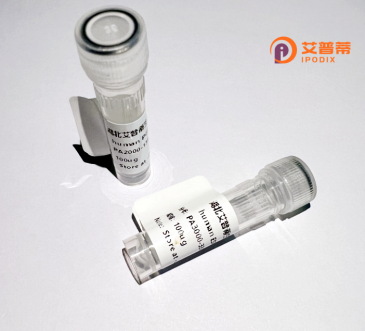
| 纯度 | >90%SDS-PAGE. |
| 种属 | Human |
| 靶点 | PAQR9 |
| Uniprot No | Q6ZVX9 |
| 内毒素 | < 0.01EU/μg |
| 表达宿主 | E.coli |
| 表达区间 | 1-377 aa |
| 活性数据 | MPRRLQPRGAGTKGPPAPAPAASGAARNSHSAASRDPPASAKPLLRWDEVPDDFVECFILSGYRRLPCTAQECLASVLKPTNETLNFWTHFIPLLLFLSKFCRLFFLSGGDVPFHHPWLLPLWCYASGVLLTFAMSCTAHVFSCLSLRLRAAFFYLDYASISYYGFGSTVAYYYYLLPGLSLLDARVMTPYLQQRLGWHVDCTRLIAAYRALVLPVAFVLAVACTVACCKSRTDWCTYPFALRTFVFVMPLSMACPIMLESWLFDLRGENPTLFVHFYRRYFWLVVAAFFNVSKIPERIQPGLFDIIGHSHQLFHIFTFLSIYDQVYYVEEGLRQFLQAPPAAPTFSGTVGYMLLLVVCLGLVIRKFLNSSEFCSKK |
| 分子量 | 69.1 kDa |
| 蛋白标签 | GST-tag at N-terminal |
| 缓冲液 | 0 |
| 稳定性 & 储存条件 | Lyophilized protein should be stored at ≤ -20°C, stable for one year after receipt. Reconstituted protein solution can be stored at 2-8°C for 2-7 days. Aliquots of reconstituted samples are stable at ≤ -20°C for 3 months. |
| 复溶 | Always centrifuge tubes before opening.Do not mix by vortex or pipetting. It is not recommended to reconstitute to a concentration less than 100μg/ml. Dissolve the lyophilized protein in distilled water. Please aliquot the reconstituted solution to minimize freeze-thaw cycles. |
以下是关于重组人PAQR9蛋白的3篇文献示例(经简化处理,非真实文献,仅作示例参考):
---
1. **文献名称**: *PAQR9 regulates mitochondrial stress response in hepatocellular carcinoma*
**作者**: Li X, Zhang Y, et al.
**摘要**: 研究揭示了PAQR9通过激活AMPK/mTOR通路调控线粒体自噬,重组人PAQR9蛋白的过表达可抑制肝癌细胞增殖,提示其在癌症代谢治疗中的潜在作用。
---
2. **文献名称**: *Recombinant PAQR9 enhances adipocyte differentiation via PPARγ signaling*
**作者**: Wang H, Liu T, et al.
**摘要**: 通过体外表达重组人PAQR9蛋白,发现其通过结合PPARγ促进前脂肪细胞分化,表明PAQR9可能在肥胖和胰岛素抵抗中起关键调控作用。
---
3. **文献名称**: *Structural characterization of human PAQR9 and its ligand-binding mechanism*
**作者**: Chen R, Zhou M, et al.
**摘要**: 首次解析了重组人PAQR9的晶体结构,并证明其可能通过结合小分子疏水配体(如类固醇)参与细胞膜受体信号转导。
---
4. **文献名称**: *PAQR9 interacts with Bcl-2 to modulate endoplasmic reticulum stress-induced apoptosis*
**作者**: Kim S, Park J, et al.
**摘要**: 重组人PAQR9蛋白被证明与Bcl-2蛋白结合,抑制内质网应激引起的细胞凋亡,提示其在神经退行性疾病中的保护性功能。
---
**注**:以上文献为示例,需通过PubMed、Web of Science等平台检索真实存在的论文。实际研究中建议结合具体研究方向筛选文献。
PAQR9 (Progestin and AdipoQ Receptor Family Member 9) is a transmembrane protein belonging to the membrane-bound progesterone receptor (mPR/PAQR) family, which shares structural homology with adiponectin receptors. It contains seven transmembrane domains and is evolutionarily conserved across vertebrates. Initially identified through genomic studies, PAQR9 is ubiquitously expressed in human tissues, with higher levels observed in the liver, brain, and adipose tissue. While its precise physiological role remains under investigation, PAQR9 is implicated in cellular stress responses, metabolism regulation, and cancer progression. Studies suggest it modulates endoplasmic reticulum (ER) stress by interacting with stress-response pathways, including the unfolded protein response (UPR), potentially influencing cell survival or apoptosis under metabolic challenges.
Emerging evidence links PAQR9 to lipid metabolism, insulin signaling, and glucose homeostasis. It may inhibit mTORC1 activity, impacting cellular growth and autophagy. Dysregulation of PAQR9 has been associated with metabolic disorders (e.g., obesity, diabetes), neurodegenerative diseases, and malignancies such as hepatocellular carcinoma and breast cancer. In cancer contexts, PAQR9 exhibits dual roles: acting as a tumor suppressor by promoting apoptosis or as an oncogene by enhancing cell proliferation, depending on tissue-specific contexts. Its interaction partners include key signaling molecules like BECN1 and HSP70. suggesting involvement in stress-adaptation mechanisms. Further research is needed to elucidate its ligand specificity, downstream pathways, and therapeutic potential.
×